House Sparrows can be snowbirds, too.
The star of stars. The starling.
An incredible carving of an American Kestrel seen at a shop in the subway level of the Mayo Clinic in Rochester, Minnesota.
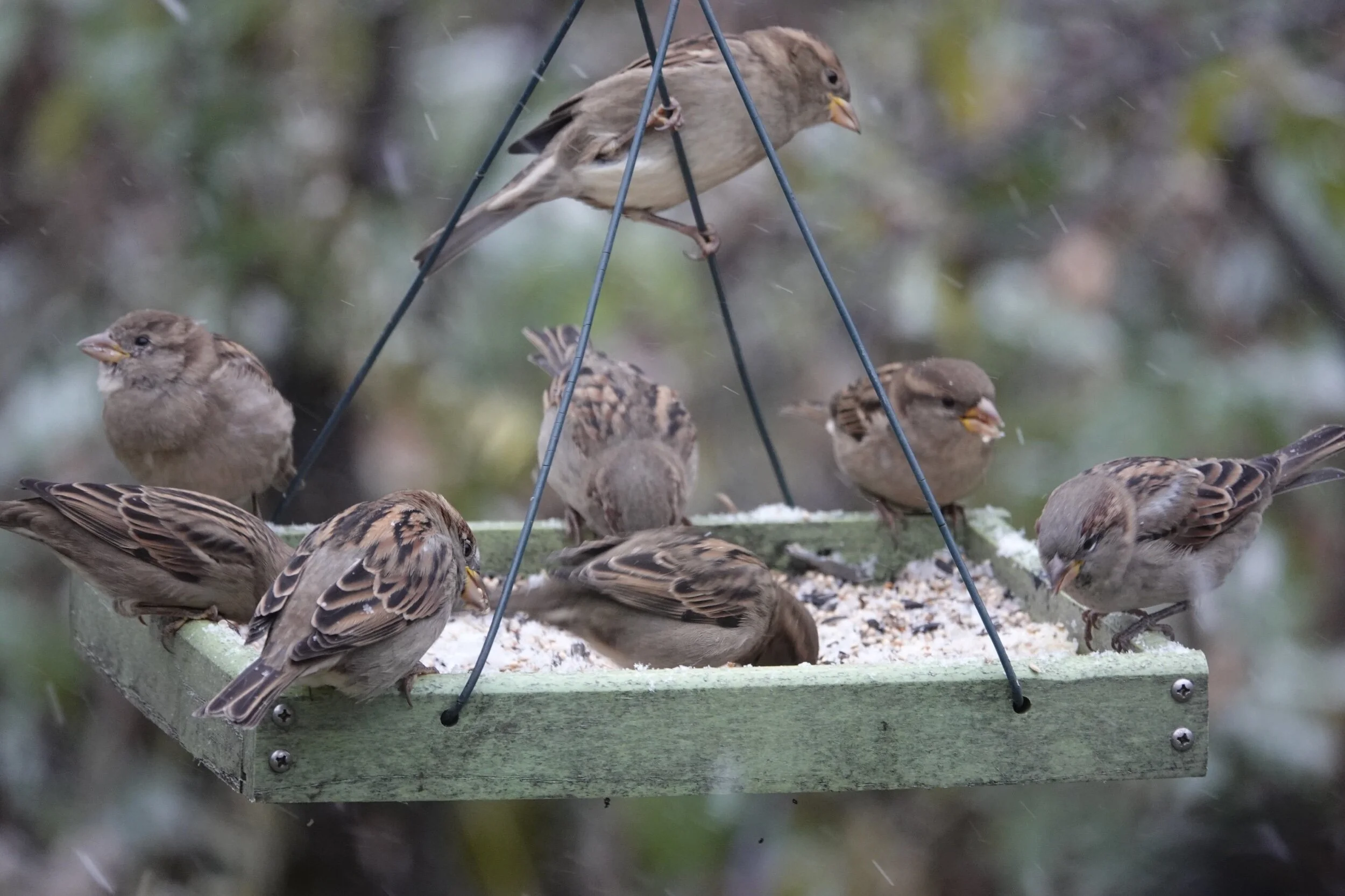
House Sparrows can be snowbirds, too.

The star of stars. The starling.
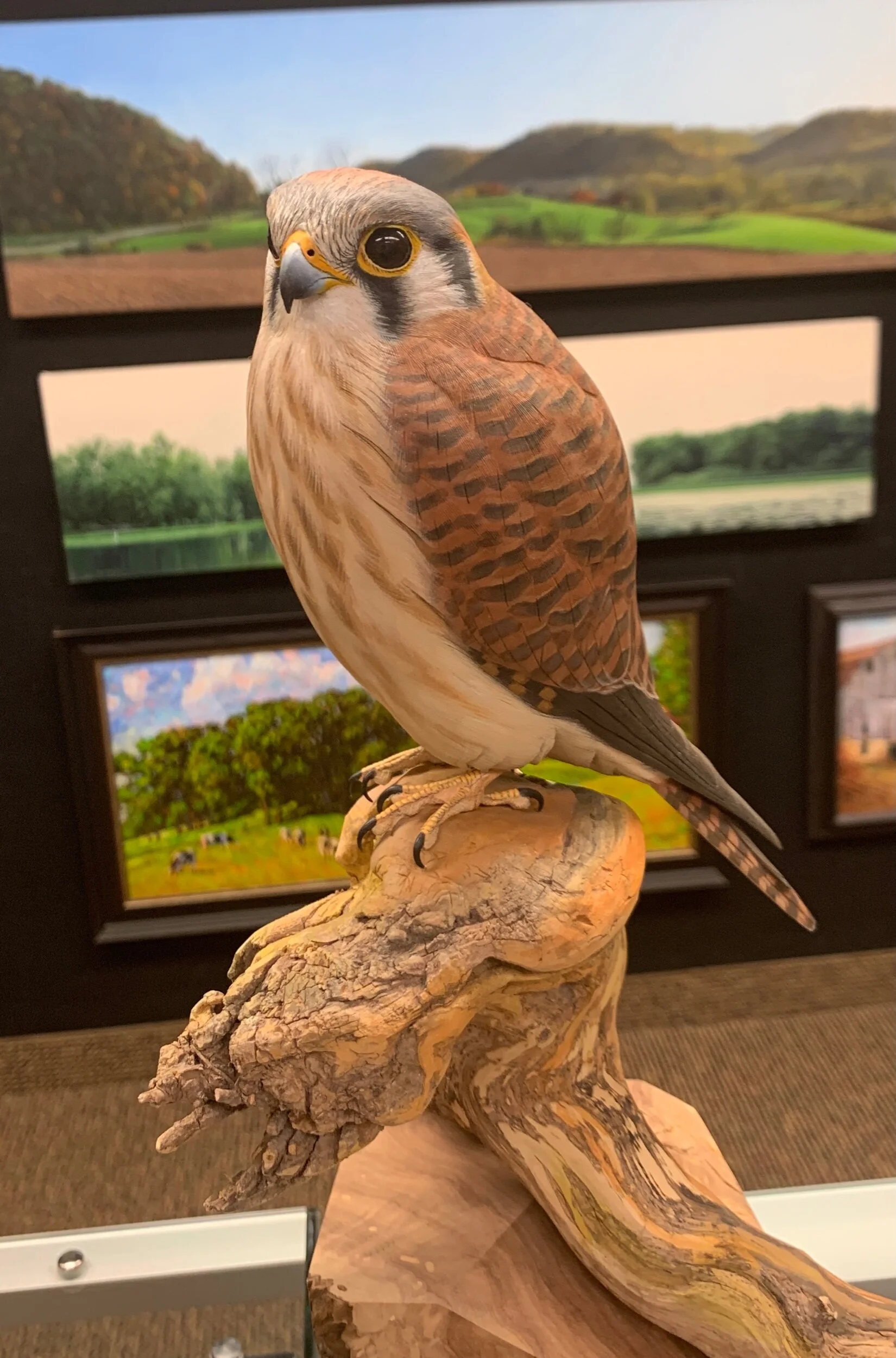
An incredible carving of an American Kestrel seen at a shop in the subway level of the Mayo Clinic in Rochester, Minnesota.
Naturally
Cricket chirps slowed with the cold before coming to a standstill after a killing frost. The silence is "Taps" for crickets, but creatures are still lurking.
A skein of geese was stirring. I saw gulls — ring-billed and Franklin's. It was a Franklin’s gull, not Ben Franklin, that said “Kek, kek!" Birding is a phenomenal pandemic pastime for people. All I need do is to watch them and my spirits are lifted. A cedar waxwing enjoyed a hawthorn apple in the yard. I enjoyed watching a cedar waxwing enjoying a haw in the yard. In the same hawthorn tree was a northern flicker, which after consuming some of the berries, appeared to be contemplating the migration ahead. Being your own GPS has to be stressful.
White-throated sparrows kicked back. They forage in the leaves on the ground, using both feet at once to scratch backward, then pounce forward on seeds or insects they’ve uncovered. The fox sparrows in the yard also use that distinctive double-scratch ground moves. With a forward and backward hop, their feet move aside leaf litter in their search for insects and seeds for dinner. An eastern phoebe was in my yard on Oct. 25, looking up in 27° weather for flying insects in the falling snow.
The starlings moved in like Cousin Eddie's family in the National Lampoon's Vacation film series. They were numerous, loud and argumentative creatures with prodigious appetites. Even the house sparrows scattered at the invasion. The house sparrow isn't a true sparrow. It's a weaver finch native to Eurasia and northern Africa that has succeeded in urban and farming areas worldwide -- including North America, where birds shipped from England were released in New York in 1851. People built nest boxes for them. The bird known as the English sparrow was brought here to combat cankerworms. By 1900 the sparrows had spread to the Rocky Mountains. By 1910, they were established in California. They're found on every continent except Antarctica.
My father once shared a hospital room with a Sparrow. No, not a house sparrow. It was a man named Sparrow. A Batt and a Sparrow in hospital beds. My father was uncomplaining, but the Sparrow chirped a lot. Just as house sparrows do.
Q&A
"I heard you mention whiffling Canada geese on your radio show. What does that mean?" Whiffling is a term used to describe the behavior whereby a bird rapidly descends with a zig-zagging, side slipping motion. It's as if they're spilling air from their wings. A goose occasionally flies briefly upside down with its head in a normal position. The aerodynamics giving lift during flying are extinguished and the goose plummets toward the ground before returning to a normal flying orientation. This erratic motion resembling a falling leaf is used to avoid a long, slow descent.
"What states are grizzly bears found?" Alaska, Idaho, Montana, Washington and Wyoming. All grizzly bears are brown bears, but not all brown bears are grizzly bears. Brown bears are generally considered to be those of the species having access to coastal food resources like salmon. Grizzly bears live inland and typically don't have access to marine-derived food resources. How does a bear stay cool in summer? It has bear conditioning.
"Should I rake the leaves or leave the leaves?" If you leave them on the lawn they give shelter for beneficial insects and the nutrients in the leaves break down and fertilize the lawn. It's a good idea to use a mower or mulcher to shred them so they break down faster and don’t smother the grass. You should clean up the leaves in areas close to open water and areas near streets and storm drains. If you don't, it could lead to water quality issues in lakes, rivers and streams because of an exacerbation of algae blooms in the spring. Some of our deciduous trees keep their leaves for much or all of winter — ironwood, buckthorn and some oaks.
"Do crows stash food?" Crows will bury food in a yard and cover it with leaves or grass. They cache food in trees, rain gutters, niches, nooks and crannies. They retrieve the stored food when it's needed. The hidden food is an insurance policy against lean times and offers convenience foods without the brick and mortar store.
Thanks for stopping by
"Those who contemplate the beauty of the earth find reserves of strength that will endure as long as life lasts. There is something infinitely healing in the repeated refrains of nature — the assurance that dawn comes after night, and spring after winter." — Rachel Carson in her book "Silent Spring"
"A good person produces good things from the treasury of a good heart, and an evil person produces evil things from the treasury of an evil heart. What you say flows from what is in your heart." — Luke 6:45
Do good.
© Al Batt 2020

Don’t call it an English sparrow because this house sparrow won’t answer. Some people call it a spatzie. It doesn’t respond to that name either. Photo by Al Batt
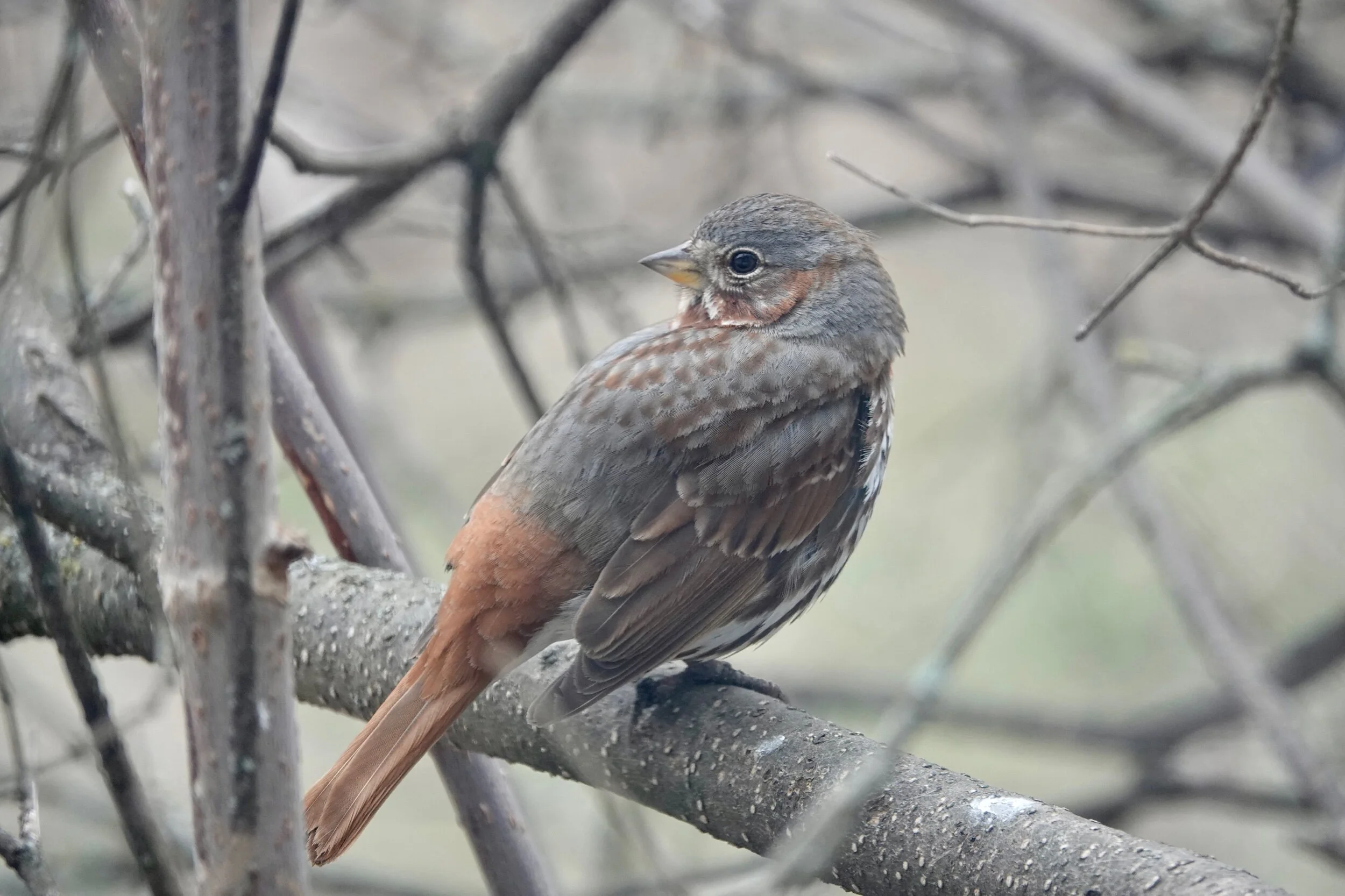
Br'er fox sparrow’s pose caused me to utter the pangram "The quick brown fox sparrow jumps over the lazy dog."
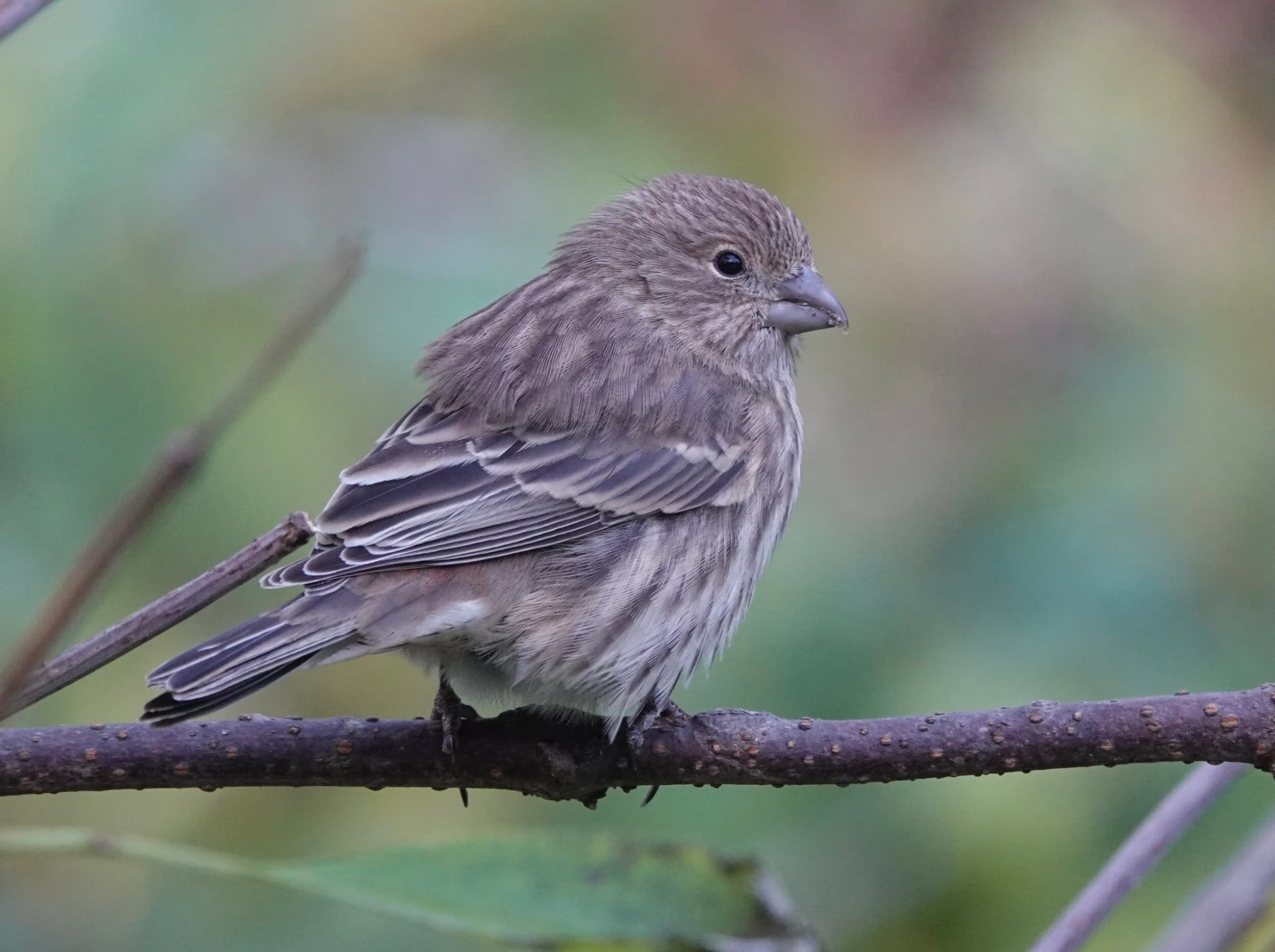
So many House Finches, so little time to stare at them.
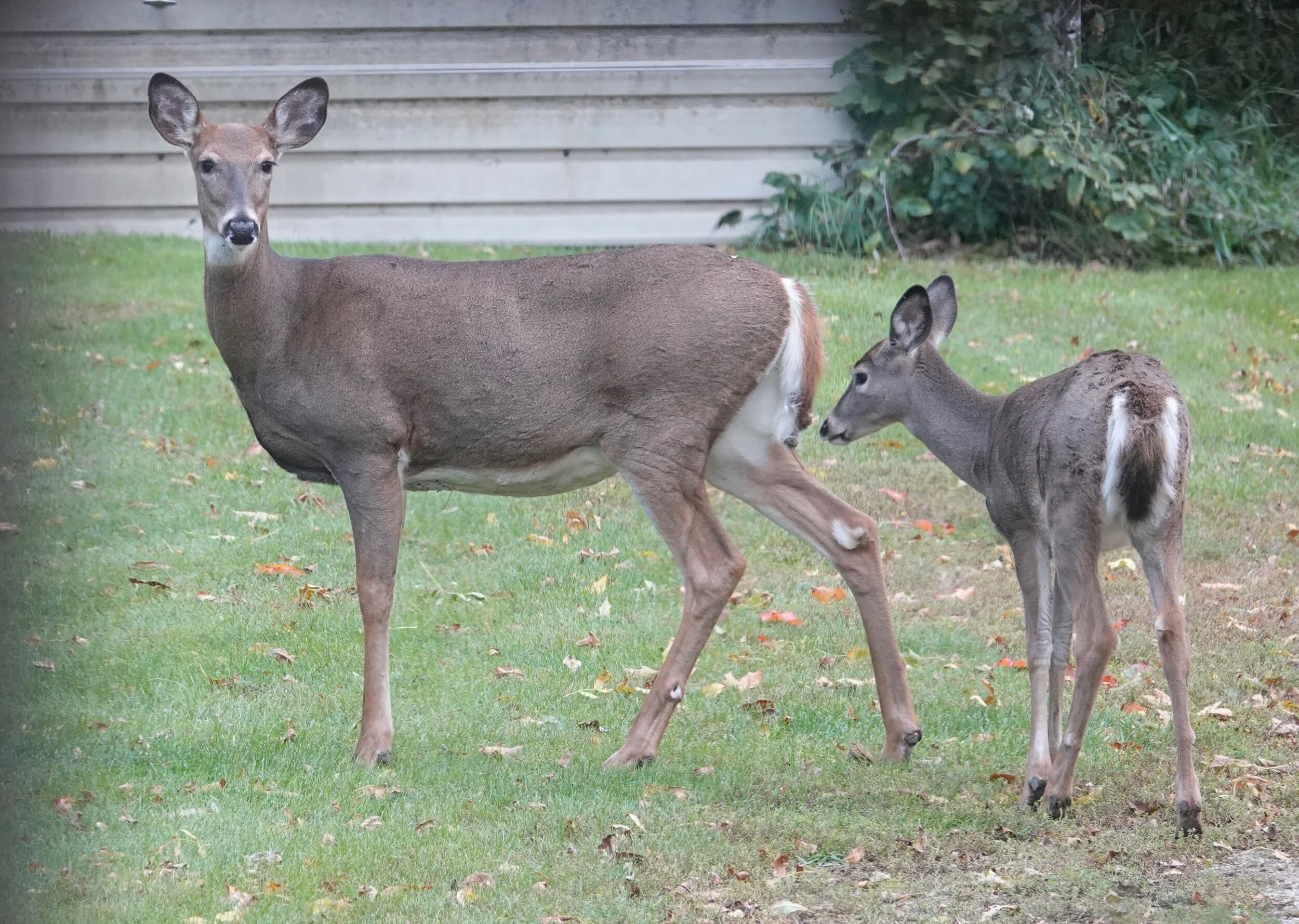
I deer you to come another step closer.

A pensive spatzie. A thoughtful House Sparrow.

A House Finch can provide a rosy outlook.

The Fox Sparrow looked a little rusty.

The mushrooms have gone with the cold, leaving my yard a spore loser.

I found a woolly bear caterpillar in the basement. I hope its being indoors isn’t indicative of a severe winter.

A cheeky chipmunk collects chow for caching.

Pine Siskins are everywhere in the Gopher State right now. I see them often feeding on road salt in Alaska and Canada during the winter.

For this hick from Hartland, Minnesota, seeing three redbirds in a single tree in my yard is a highlight.

A female Purple Finch looks for a gift shop as any traveler would.
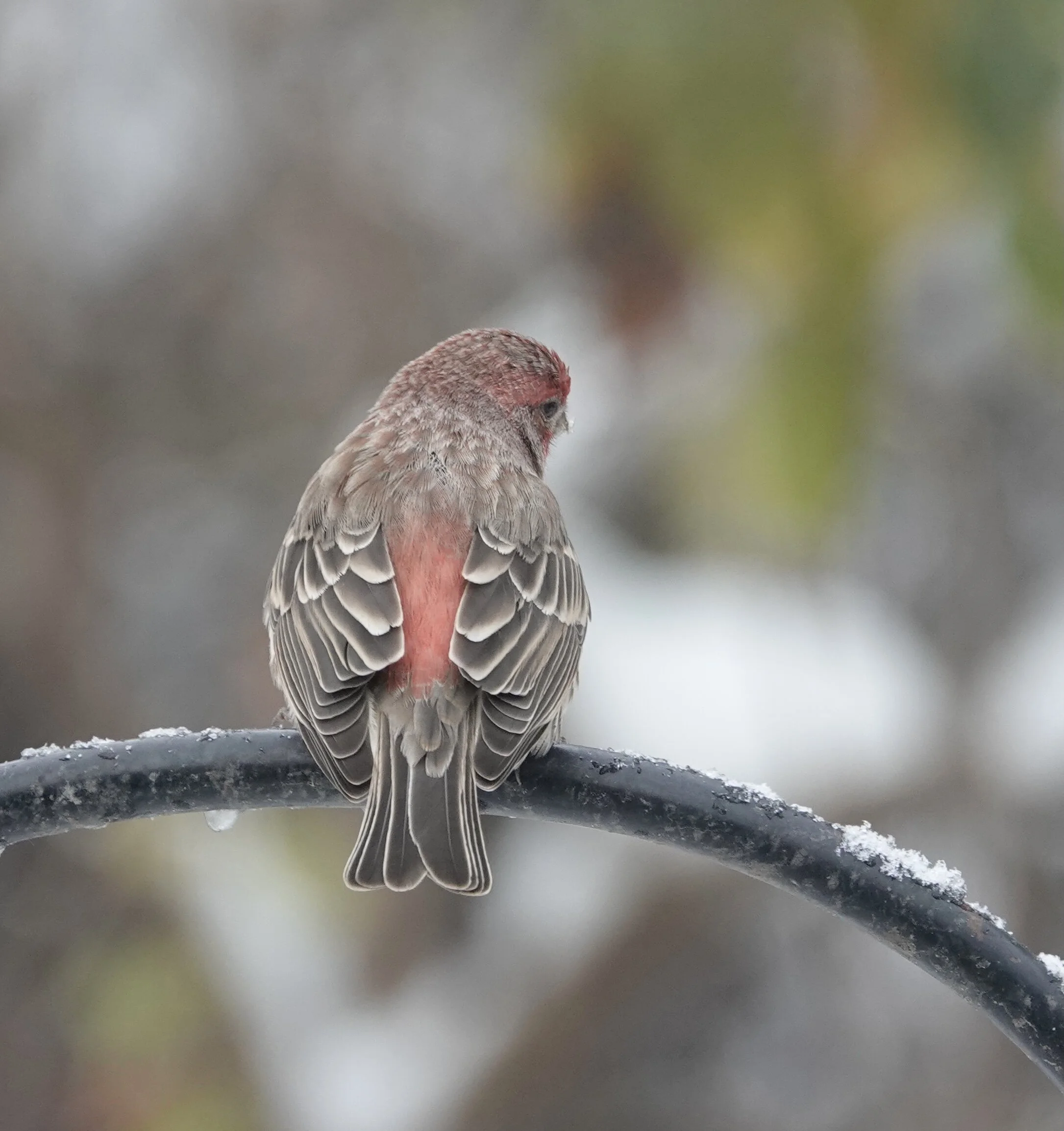
No matter which way you look at it, the House Finch male brings a bit of color to a snowy landscape.
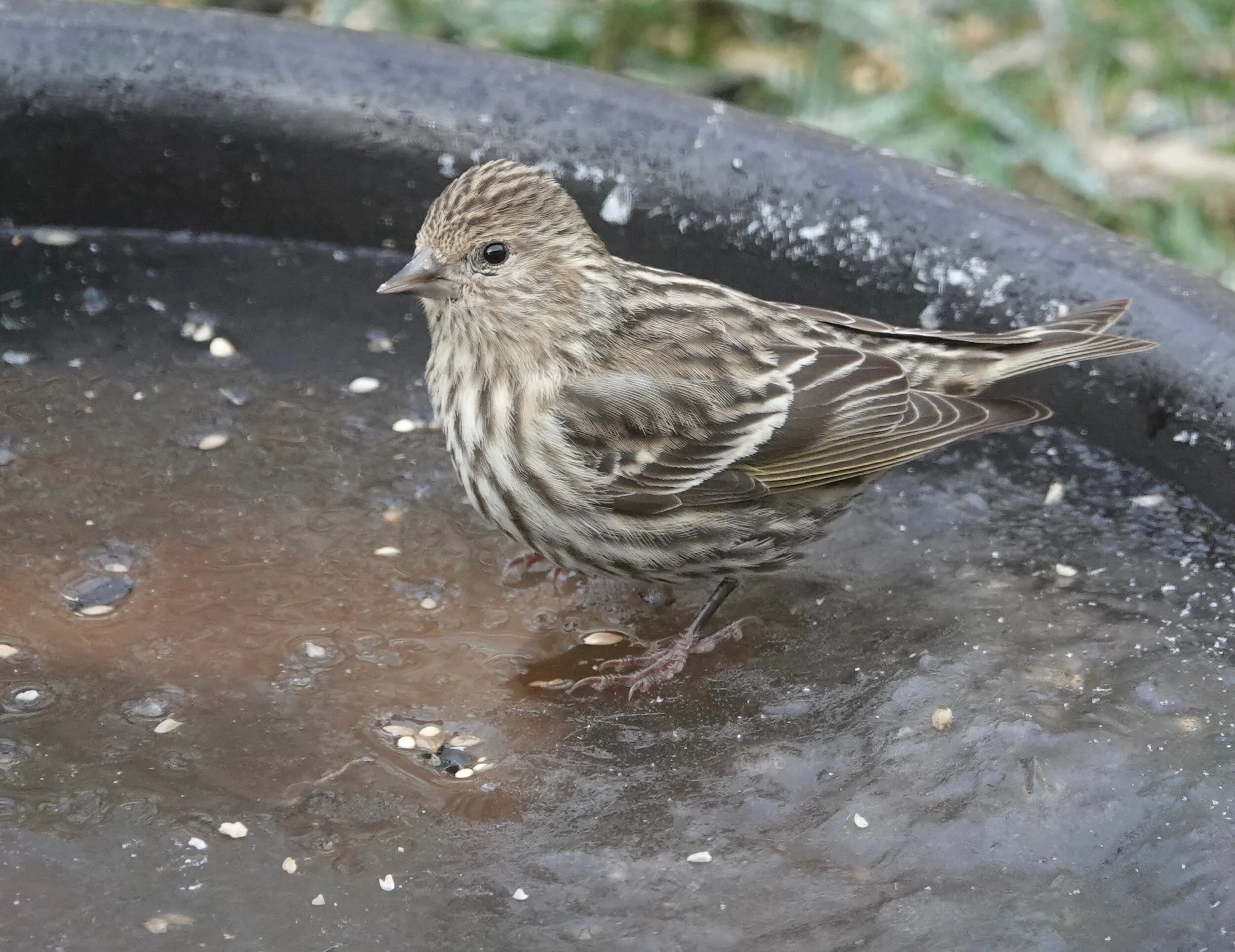
I’m always so happy to see that first Pine Siskin of the darkening seasons, it’s as if the tiny bird is capable of walking on water.
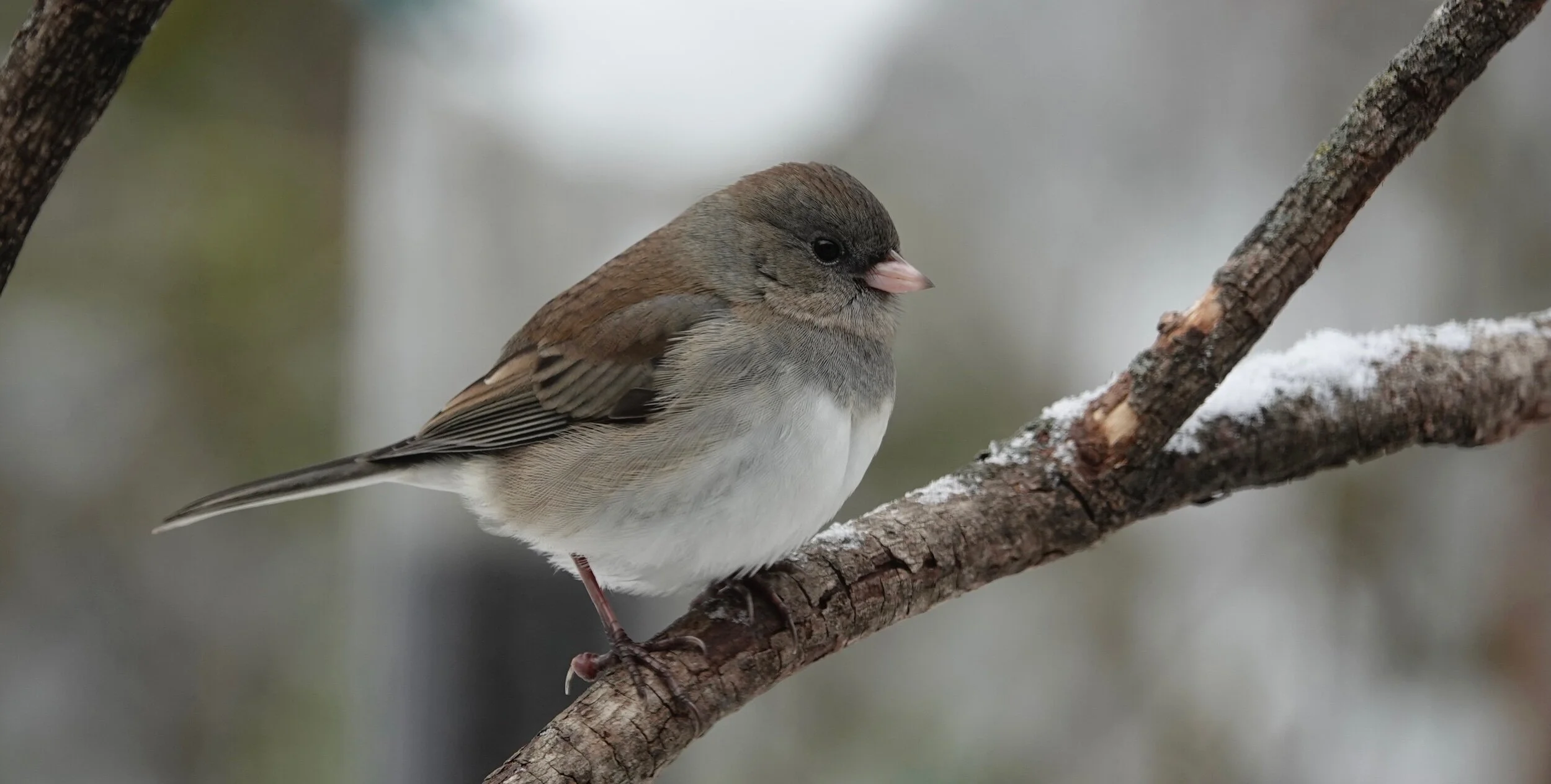
A snowbird finds snow.

And Jerry Mathers as the Beaver.

The White-breasted Nuthatch knows what you did.

It’s a good thing bees don’t have ears. If they did, all that buzzing would drive them crazy.

A squirrel is showing what a wild turkey would look like with a toupee.
Naturally
Autumn colors popped and fell. Unlike Maxwell House coffee, whose slogan is "Good to the last drop," a leaf is good after the last drop. The leaves on the ground are beautiful unless you detest raking them.
The frost had deleted most of the wasps and bees. Emily Dickinson wrote, "The pedigree of honey does not concern the bee; a clover, any time, to him Is aristocracy." The bees that do all the work are females. That might surprise no one.
I listened to blue jays go on and on. Mark Twain wrote, “A bluejay is human; he has got all a man's faculties and a man's weakness.” I figured these were discussing the merits of the electoral college. Mark Twain also wrote, “You never saw a bluejay get stuck for a word. He is a vocabularized geyser."
Horned larks gathered on the roadside on a windy day. There was and might still be a brand of cigarettes called Lark. I have never seen a horned lark smoking one. A road-killed muskrat wasn't far from the larks. The muskrat is commonly known as Ondatra zibethicus and rightly so. Captain & Tennille sang “Muskrat, muskrat. Candlelight. Doing the town. And doing it right. In the evening, it's pretty pleasing. Muskrat Suzie, Muskrat Sam. Do the jitterbug at a Muskrat Land. And they shimmy, Sam is so skinny.” I have nothing to add to that.
Brenda Kotasek of St. Peter volunteers at the fabulous Henderson Hummingbird Garden and saw the last hummingbird on Oct. 6 and last monarch butterfly on Oct. 8.
My feeders were so busy, I expected to hear "Yackety Sax," the song played during the chase scenes on "The Benny Hill Show." Pine siskins seemed to be everywhere. The wind, white-throated sparrows and chickadees whistled. So did the temperature as it whistled past my ears on its way down. Harris's sparrows, which I sometimes hear whistle as they pass through in the spring, magically appeared. I whistled on their behalf. Why not? As Monty Python's Eric Idle sang, "When you're chewing on life's gristle, don't grumble, give a whistle."
Q&A
"How fast can a mole tunnel?" I read something from Purdue University saying moles can tunnel 100 feet per day. I've been told and read often that they can dig 160 feet in a single night, but couldn't find research documenting that. Moles nest deep underground but make tunnels as they burrow through the soil in search of food. Surface tunnels are the raised ridges in lawns created by moles working just below the surface. Folkloric remedies haven't proven effective in discouraging moles.
"What can I do about powdery mildew on lilacs?" Learn to ignore it. It's a cosmetic disease as it is on most woody ornamentals.
"Do you recommend using pruning paints on trees?" No, research has found they slow natural healing. You might use them if you're forced to prune an oak during the growing season. It keeps sap beetles from finding the wound, which they'd find almost immediately and possibly transmit oak wilt. Latex house paint would work as all that is needed is a physical barrier.
"Why does a monarch butterfly chrysalis have gold on it?" Chrysallis is from the Greek chrysallid, which is from chrysos meaning "gold," referring to the metallic gold-like sheen of some butterfly pupae. The gold is created by a coupling of a carotenoid pigment and hill-like structures that reflect light from their peaks. There are theories as to the purpose of the gold. It could act as camouflage -- mirroring colors of the surroundings and breaking up the shape of the pupa or it might look like dew droplets. It could be a warning coloration, which acts like a "Poison" sign. Or it might filter particular wavelengths of light, which might be harmful to the monarchs.
"What is the one thing that most often becomes litter?" According to the Ocean Conservancy, the top 5 most littered items are: 1. Cigarette butts 2. Food wrappers 3. Plastic bottles 4. Plastic bottle caps 5. Plastic bags.
"Why do robins molt right before they migrate south?" Robins molt so they'll have fresh feathers for the flight. These fresh feathers are better insulation against the winter cold. Robins start molting flight feathers in mid-June and finish molting by early September. They molt body feathers from late July into October. Each feather is pushed out by a new one. Most feathers last a year, but if a feather is pulled out when a robin isn't molting, it's replaced promptly.
Thanks for stopping by
"Tell me, O Octopus, I begs. Is those things arms, or is they legs? I marvel at thee, Octopus; If I were thou, I'd call me Us." — Ogden Nash
"God in his wisdom made the fly. And then forgot to tell us why." — Ogden Nash
Do good.
©Al Batt 2020

A Harris’s sparrow is a handsome sparrow. North America’s largest sparrow breeds only in Canada. Photo by Al Batt

Eventually, everything is repurposed into something for birds.

A Blue Jay will fly across five state lines for peanuts. At least that’s its campaign promise.

A robin has a great sense of humor. This one is enjoying a haw.

How much wood would a woodpecker peck if a woodpecker would peck wood? I’ve been hearing from homeowners with cedar shakes who are learning the answer to that question.

A lovely singer, the House Finch was once sold in the illegal pet trade as a Hollywood Finch.
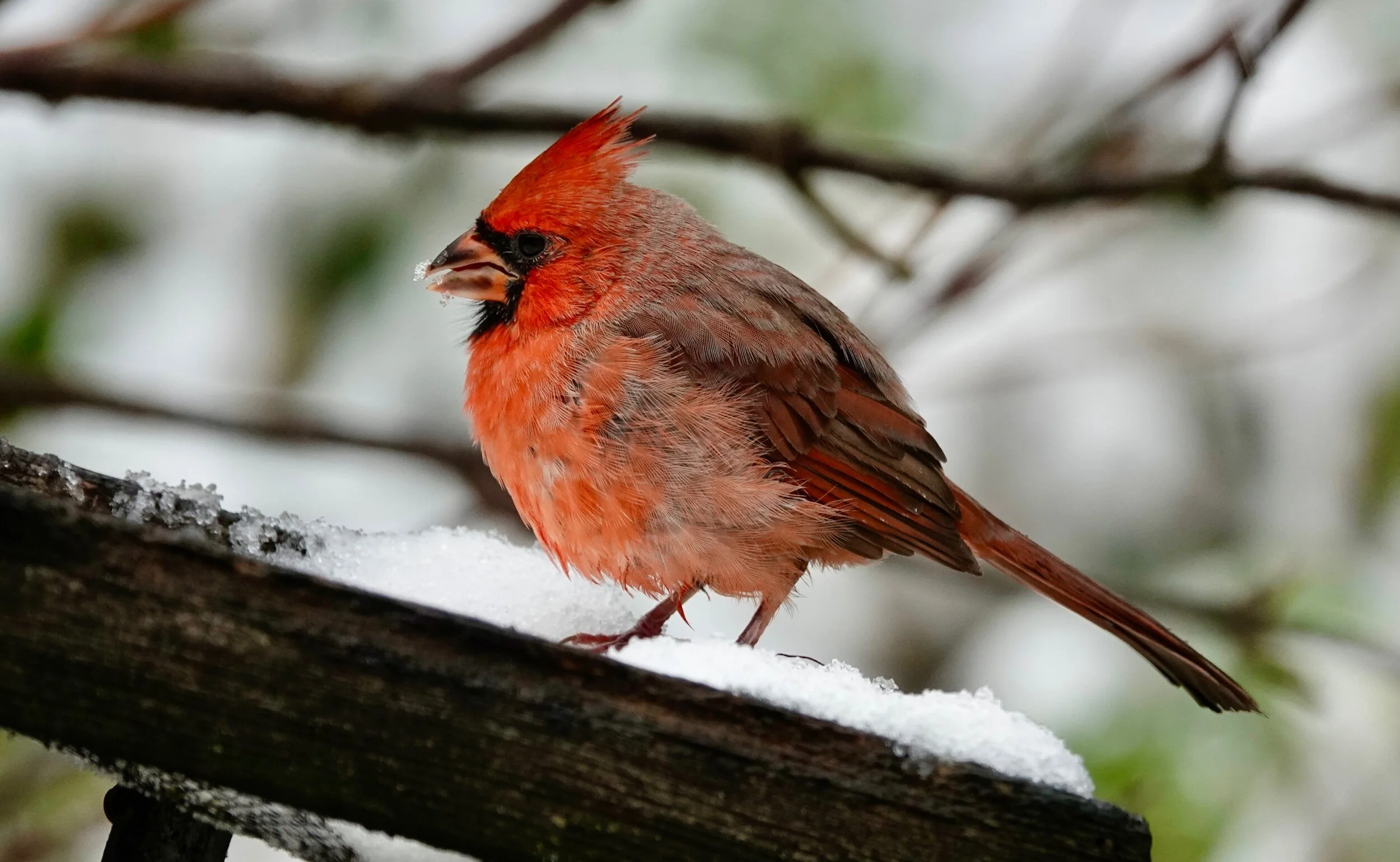
Red and white. Fight, fight, fight. A cardinal in the October snow.
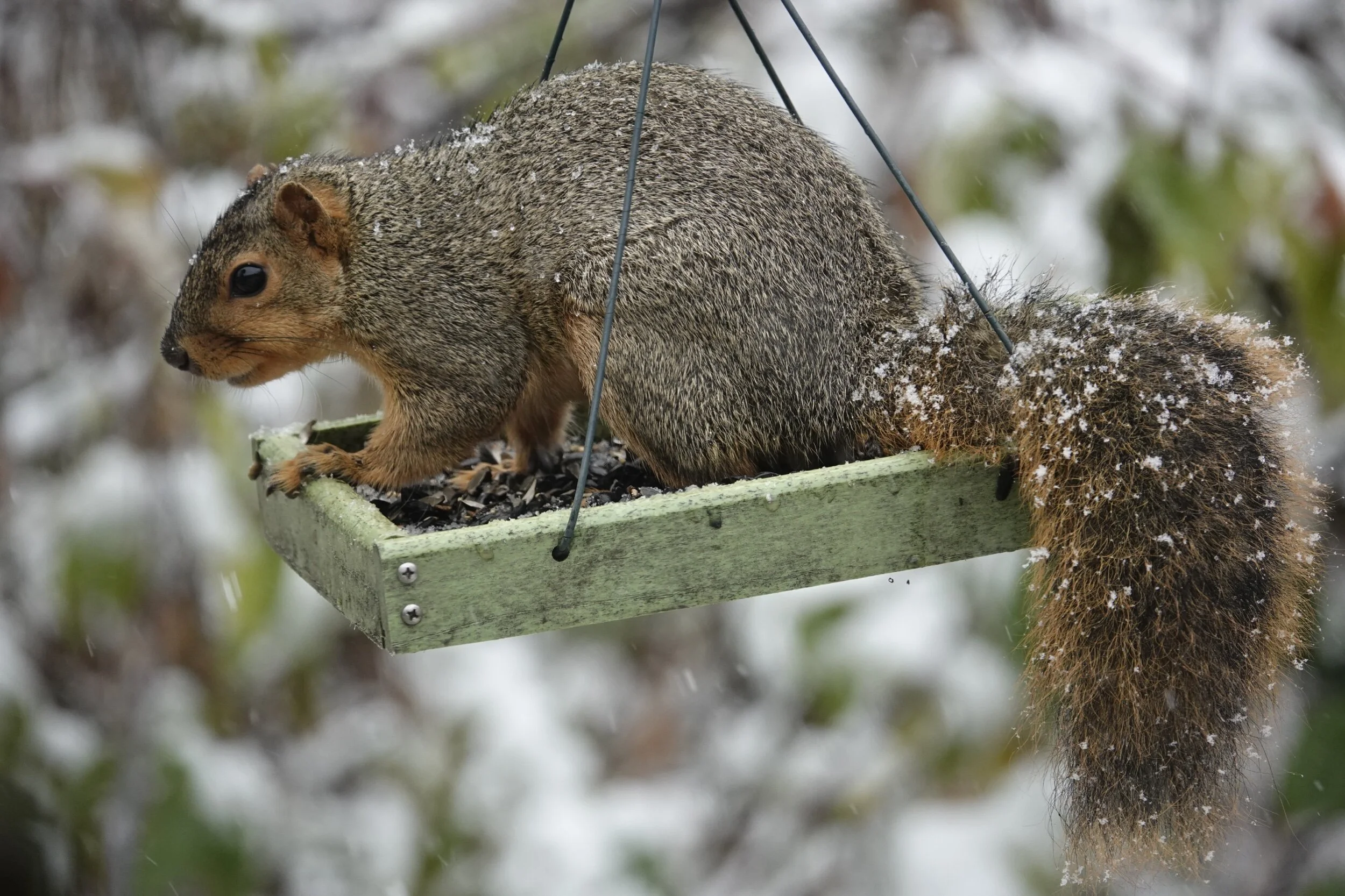
A tail of snow. The Fox Squirrel’s first snow.
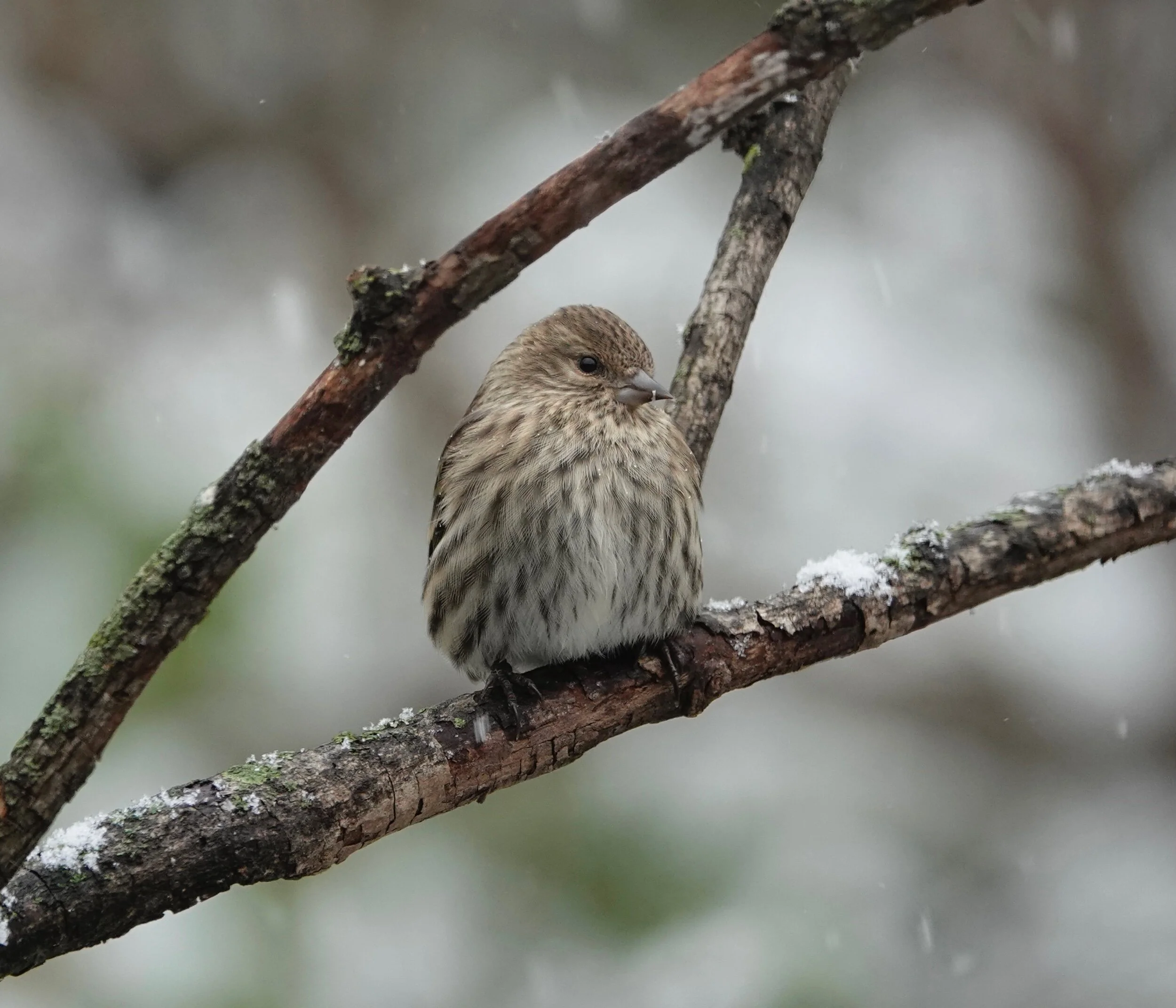
A Pine Siskin pining for a pine tree in the snow. Siskin derives from the sound the bird makes.

Is this the first time this starling had ever seen snow?

A Cedar Waxwing enjoys a hawthorn apple. I enjoyed watching a Cedar Waxwing enjoying a hawthorn apple.

A Northern Flicker contemplates the migration ahead. Being your own GPS has to be stressful.
https://soundcloud.com/kmsu/put-out-your-feeders-al-batt-10202020?in=kmsu/sets/birding-with-batt
Al Batt
Twitter http://twitter.com/batt_allen
Podcast https://soundcloud.com/kmsu/sets/birding-with-batt
Blog http://www.albatt.com/blogs
Podcast http://ktoe.com/2020/05/22/5-22-20-lisa-with-al-batt


Purple Finch in the background.

House Finch in the foreground.

Purple Finch, then a House Finch.

My father once shared a hospital room with a Sparrow. No, not this House Sparrow. It was a man named Sparrow. A Batt and a Sparrow. My father was uncomplaining, but the Sparrow chirped a lot.

A Brown-headed Cowbird without a cow.

The smallest North American woodpecker is the Downy Woodpecker.

A Pine Siskin puffs up.

A well-dressed starling.
Naturally
The day was a humdinger; Mother Nature must have moved her world headquarters to my neighborhood. Most of the deciduous trees were engaged in making their leaves colorful. Virginia creeper vined in bright red leaves.
Nature is the ship on which I sail. There's always something worth noticing. Large black ants hurried. I heard music. I think it was a carpenter anthem. Let there be ants. And let there be eaters of ants like northern flickers. The male flicker has a black mustache. For an ant, a flicker is the skunk at the party.
Once I start watching birds, I become too lazy to stop. My capacity for astonishment becomes endless. A chickadee cached sunflower seeds in a divot in a power pole. The tiny bird was investing in utility stocks. Crows produced a natural noise as jays gave me an earful. I was unable to get a word in edgewise. I’ve read of a group of jays called a party, band, cast and scold. I use "a bunch of jays" more than anything else. Something plural flew past my head. Multi-colored Asian lady beetles. Maybees were on the flowers. That's my nickname for bee mimics, flies that resemble bees. Bee mimics are other insects that resemble bees. This is called Batesian mimicry, which means something harmless is imitating something dangerous. Most bee-lookalikes are hoverflies. These harmless flies cannot sting.
Portland, a Texas city on the coast, claims properly that it's always feather weather there. I know that's true, but it was feather weather in my yard, too, thanks to the white-throated sparrows scratching for grub on the ground. They took occasional breaks to whistle a bit. Whistling is a white-throated sparrow’s superpower. A caller asked why some of the birds had tan stripes while others had white stripes. This lovely bird, with a declining population, comes in two forms — those with tan stripes and those with white stripes. Those with white stripes are the most aggressive. Males of both forms want to mate with females with white stripes, but females of both forms prefer tan-striped mates. So it all works out. I wish birds had a mailbox so I could send them an appreciative postcard.
A phalanx of blackbirds moved past as I walked at the edge of a lake at a state park on a quiet day. I checked logs in a bay and was rewarded with good looks at turtles. Hope springs a turtle. Pelicans flew over, their wings made sounds as if they were swinging ropes.
Q&A
Tom Jessen of Madelia wrote, "If all cowbirds are raised by other species, how are they able to communicate with each other after leaving the host nest and joining the flock?" Cowbirds are brood parasites, meaning they ditch their eggs in the nests of other species and allow the foster parents to do the hard work of raising the chicks. Cowbirds have parents that don't look or act like them. Behavioral scientists are working on an answer. Cowbirds learn to recognize other cowbirds through sound and sight. Some scientists believe adult cowbirds stick around after the eggs are laid and maintain contact with the hatchlings, which is how the chicks learn the ways of the cowbird. In response to hearing the begging cries of baby cowbirds, female cowbirds respond by calling to them. When a young cowbird is able, it begins to visit adult cowbirds. It's an amazing story.
Rick Mammel of Albert Lea asked how long to keep a hummingbird feeder up in the fall. I keep mine up 7 to 10 days after I see the last hummingbird in case there are any stragglers. A feeder doesn't delay their migration.
"Are insect numbers declining?" The German Centre for Integrative Biodiversity Research did a worldwide compilation of insect abundance that showed land-dwelling insects are in decline. On average, there is a global decrease of 0.92% per year. The number of insects living in freshwater has increased an average of 1.08% each year. Local trends are highly variable.
"Where do Minnesota's trumpeter swans migrate?" They are short-distance migrants, with the vast majority of the breeding population migrating only as far south as central and southern Minnesota to sites where there is open water and an abundant food supply. A power plant site that hosts thousands of wintering swans is Xcel Energy’s Monticello Nuclear Power Plant along the Mississippi River, which has local efforts that feed the swans. Some have migrated to Iowa, Missouri and Arkansas. Single swans, sibling groups, young pairs and failed breeders leave their summer territories first, followed by pairs with cygnets. They migrate in small family groups to wintering grounds.
Thanks for stopping by
"Voting isn’t the most we can do. But it is the least." — Gloria Steinem
"I get mail; therefore I am." ― Scott Adams
Do good.
©Al Batt 2020

The male northern flicker has a black mustache, which is lacking on a female. Photo by Al Batt

Hitchhiking is habit that gulls find hard to kick.

A deer pretending to be the shadow of a tree.

It was a Franklin’s Gull, not Ben Franklin, that said “Kek!:

A scavenger hunt for Blue Jays.

The temperature whistled past my ears on its way down. Harris's Sparrows, which I sometimes hear whistle as they pass through in the spring, magically appeared.

The temperature whistled past my ears on its way down. Harris's Sparrows, which I sometimes hear whistle as they pass through in the spring, magically appeared.

I whistled on behalf of a silent Harris’s Sparrow. As Monty Python's Eric Idle sang, "When you're chewing on life's gristle, don't grumble, give a whistle."

Battered, weary and beautiful. The leaf is a tiny sun illuminating my world.

There used to be and might still be a brand of cigarettes called Lark. The Horned Lark has never been seen smoking one.

The song of the Horned Lark has been described as a "tsip, tsip, tsee, didididi." I believe fellow Minnesotan, Bob Dylan, might have included that in a number of his songs.

The Muskrat is commonly known as Ondatra zibethicus and rightly so.

Captain & Tennille sang “Muskrat, muskrat. Candlelight. Doin' the town. And doin' it right. In the evening, it's pretty pleasing. Muskrat Suzie, Muskrat Sam. Do the jitterbug at a Muskrat Land. And they shimmy Sam is so skinny.” I have nothing to add to that.

A Blue Jay performing its morning ablutions.

Mark Twain wrote, “A bluejay is human; he has got all a man's faculties and a man's weakness. “

Mark Twain wrote, “You never saw a bluejay get stuck for a word. He is a vocabularized geyser. “